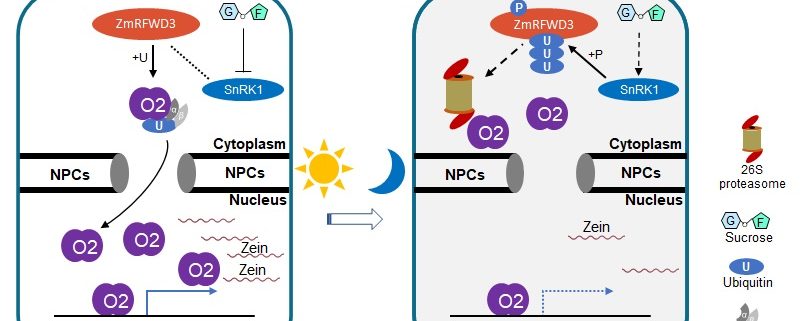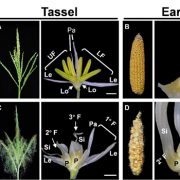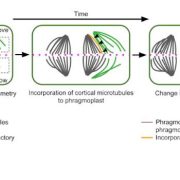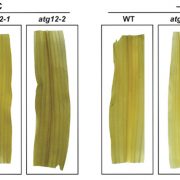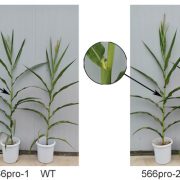Rhythms in the dark: how endosperm responds to daylight cycles
Li et al. discover a diurnal pattern in sucrose content in developing maize endosperm that relies on the action of an E3 ubiquitin ligase on the master regulator transcription factor Opaque2. Plant Cell https://doi.org/10.1105/tpc.20.00352
By Chaobin Li, Zeyang Ma, Rentao Song, China Agricultural University
Background: Circadian rhythms allow plants to synchronize their physiology and biochemistry to the daylight cycles caused by the rotation of the Earth around the Sun, thereby optimizing their growth and development. Sucrose, synthesized in green tissues, is not only a nutrient but also serves as a signaling molecule. Sucrose signaling plays a key role in the circadian process, by regulating genes encoding circadian clock components in photosynthetic tissues. However, aside from roots, whether other non-photosynthetic tissues display circadian rhythms is unknown. In non-green tissues, such as developing seeds, nutrient (carbon and nitrogen) accumulation largely depends on the supply from the mother plant. Although about 90% of the carbon arriving in developing seeds is in the form of sucrose, whether it serves as a signal and entrains diurnal rhythms in seeds remains unclear.
Question: Does sucrose function as a signal contributing to the diurnal rhythmic regulation in non-photosynthetic storage organs, such as developing seeds?
Findings: We showed that carbon and nitrogen assimilation in developing maize seeds is coordinated by diurnal rhythmic sucrose concentrations. We found that sucrose (carbon) and storage protein (nitrogen) levels exhibit diurnal accumulation patterns in maize seeds. SnRK1, which is a low-sucrose-activated protein kinase, triggers the degradation of the E3 ubiquitin ligase ZmRFWD3 via phosphorylation. Moreover, ZmRFWD3 ubiquitinates Opaque2, the key transcription factor for maize seed storage protein biosynthesis, which enhances O2 nuclear localization and transcriptional activity. We also demonstrated that O2 activity is diurnal and entrained by the aforementioned diurnal sucrose accumulation patterns. Therefore, we discovered a SnRK1-ZmRFWD3-Opaque2 signaling axis that transduces the diurnal sucrose signals from the mother plant, and establishes diurnal nitrogen accumulation patterns in developing maize seeds.
Next Steps: This newly discovered signaling axis is not the only one regulating diurnal rhythms in maize seeds. We will attempt to characterize other diurnal rhythm signaling axes in developing maize seeds. At the same time, we will try to manipulate these signaling axes to alter the starch or protein levels in maize seeds, with the hope to breed special maize lines with an extremely high level of protein or starch.
Chaobin Li, et al. (2020) A SnRK1-ZmRFWD3-Opaque2 Signalling Axis Regulates Diurnal Nitrogen Accumulation in Maize Seeds. Plant Cell DOI: https://doi.org/10.1105/tpc.20.00352


